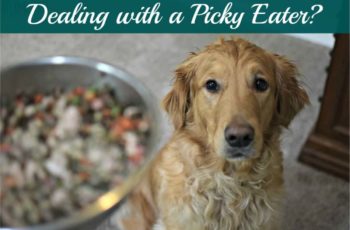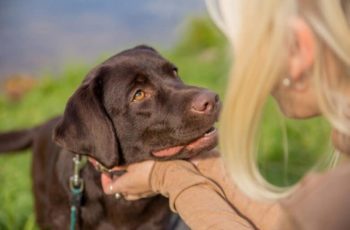This post may contain affiliate links. We may earn money or products from the companies mentioned in this post.
If you have a dog, chances are you’ve seen pig ear chews for dogs at your brick and mortar pet retail store or online.
They’re becoming more and more popular these days, but what exactly is the deal with them and are pig ears good for dogs?
That’s what we’ll look at in today’s blog post, along with how they compare to rawhide, whether or not you can leave your puppy alone with a pigs ear and if dogs can contract salmonella from this type of dog chew!
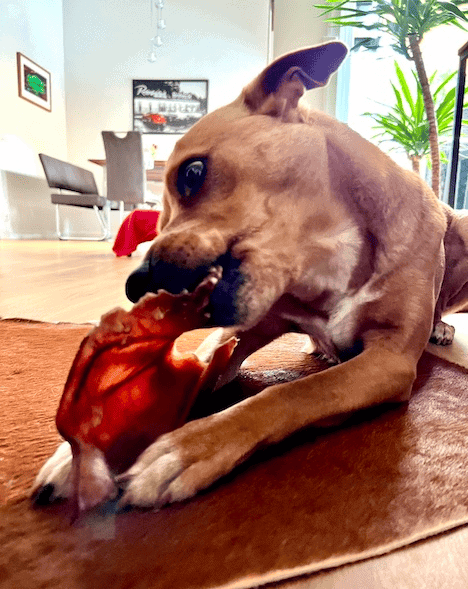
Pig Ear Dog Treat – What’s In It?
First things first, (most) pig ears are single-ingredient dog chews.
That means you won’t find any artificial flavors, preservatives, colors, grains or anything else on the ingredient list.
There’s literally only pig ear in this dog chew – unless you buy a smoked pig ear, and we’ll cover the downsides of that later in this blog post.
But non-smoked pig ears are high in protein, moderate in fat and consist mostly of soft cartilage and skin.
That also means that it’s naturally rich in glucosamine and chondroitin as those are the building blocks of cartilage!
As far as pigs ear calories, they pack a decent punch with 100-200 calories per pig ear, depending on its size.
Next, let’s look at what all of this means for your pup.
6 Benefits Of Pig Ears For Dogs
1. Rawhide Alternative
You may know that bleached rawhide is treated with chemicals and is notorious for causing blockages because it’s not fully digestible.
Thankfully, pig ears are not rawhide, not even close!
As you can see in the picture below, they’re not synthetic bright white like rawhides but pig ears have their natural brow-reddish color.
That lack of chemicals makes pig ears fully digestible and turns them into a safe rawhide alternative dog chew.
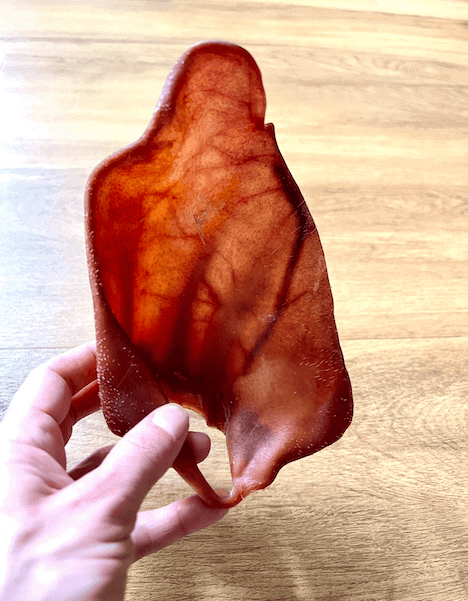
2. Supports Oral Hygiene
Pig ears help scrape away tartar and plaque from dog teeth.
Additionally, they exercise your dog’s jaw muscles and massage their gums.
That’s particularly beneficial for teething puppies whose gum lines hurt as their adult teeth are starting to come in!
3. Prevents Stress & Boredom
Did you know that chewing is a natural stress-relieving and entertaining behavior for dogs?
That’s why it’s important to encourage regular chewing sessions along with appropriate dog chews in your pups, regardless of their age.
Yep, puppies benefit from chewing as much as adult and senior dogs do!
So next time your puppy tries to go for a chew session on your woodwork, furniture, or couch, offer them a pig ear instead!
You’ll see that a good chew session keeps boredom at bay and provides mental stimulation.
Chewing can also be really beneficial in dogs who are scared of thunder and fireworks sounds.
4. Helps Support Joint Health
Pig ears help support your dog’s joints because they’re naturally rich in glucosamine and chondroitin, the building blocks of cartilage.
After all, your dog’s joints are made of cartilage!
That’s why it’s a good idea to offer your pup pig ears as a joint preventative on a somewhat regular basis – right along with keeping your pup at a healthy weight.
Because let’s face it, excessive weight adds unnecessary pressure on your dog’s joints, which makes it harder for your pup to move around and be active.
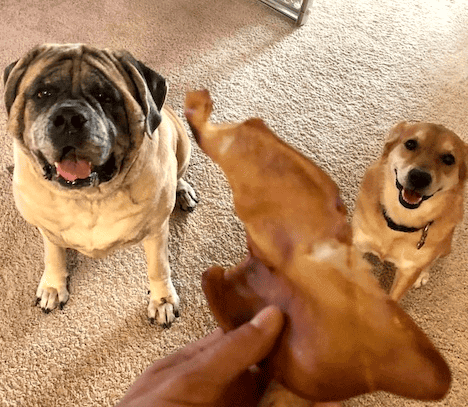
5. Promotes Healthy Muscles & Skin
Pig ear treats are naturally rich in protein with 20-30 grams of protein per ear.
Protein is super important to build and maintain your dog’s skin & muscle tissue as well as their skeletal health.
6. Great For Dogs With Food Sensitivities
Pork ears are also a great dog chew for dogs with allergies or sensitivities to grains and starches as well as common proteins like chicken, beef or fish.
So if your pup doesn’t do well with Milkbone treats, chicken feet, bully sticks or salmon skins, try offering them a pig ear instead!
My pup Wally, for example, gets super itchy whenever he has anything made from chicken or salmon, and the same applies to any food or chews with grains.
So I mostly stick to treating him with single-ingredient dog chews, and pig ears are definitely one of them!
Any Cons?
Well, as much as pig ears are great for dogs with sensitivities to proteins other than pork, they’re a no-no for dogs with pork allergies!
Pig ears are also not a long lasting chew for power chewers.
Remember that they mostly consist of soft cartilage and not hard bone like antlers, for example.
Just for reference, my 38 lb pup Wally is a moderate chewer and finishes a whole pig ear in about 15-20 minutes.
That means a power chewer can easily go through a pig ear in 5 minutes or less.
Since pig ears have quite a few calories, they’re also not a great dog chew for overweight dogs who don’t exercise regularly.
Which brings us to the next question.
How Many Pig Ears Can I Give My Puppy?
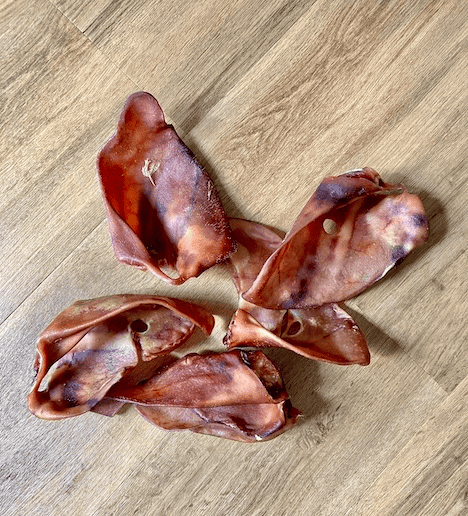
That’s important to know because remember that pig ears are a calorie-rich food?
Well, it really depends on the size of the pig ear as well as on your dog’s size and activity level.
Generally speaking, smaller pig ears or half pig ears are a better size for puppies and small to medium size dogs.
Whole pig ears as well as jumbo pig ears are best for large to extra large dogs.
That said, if your pup’s at their target body weight and not chubby or obese, you should be able to give them a pig ear once a week.
But your pup’s activity level and life stage plays an important role in the amount of pig ears they can have, too.
When Can Dogs Eat Pig Ears Every Day?
If they exercise 2-3 hours per day and have weekly agility practice sessions in combination with agility trials on the weekend, they’re burning a lot of calories.
That means they’ll be fine with several pig ears per week, potentially even one per day.
The same applies to puppies who need considerably more calories while they’re growing compared to their adult and senior counterparts.
But if your couch potato Bulldog eats a pig ear every day and only gets to walk their neighborhood for 30 minutes, they’ll get chubby real quick.
Are Pig Ears Safe For Dogs or: Can I Leave My Dog Alone With A Pigs Ear?
We already covered the fact that unlike rawhide, pig ears are fully digestible, so your pup shouldn’t have any issues there.
If they’ve never had a pig ear, it’s probably best to introduce it slowly to prevent an upset tummy, especially if your dog is known to have an overly sensitive stomach.
If they don’t reliably respond to a “leave it” command, you can hold one end of the pig ear and let your pup chew on the other end.
After 5 minutes or so, take it away and let them continue chewing on it the next day.
As far as leaving your dog alone with a pigs ear, it’s safer not to.
Even if your dog is a seasoned chewer, there’s always a small chance they may choke on it for whatever reason.
As a general rule of thumb, it’s best to supervise your pups when they’re busy with any type of chew – regardless of whether it’s an antler, a bully stick or a pigs ear.
That also means that it’s not a good idea to leave your pup home alone in their crate with a pig ear.
A filled and frozen KONG dog toy is a much better crate companion when you’re not home to supervise.
But I digress.
Are Baked Or Smoked Pig Ears Better For Dogs?
Generally speaking, the less processed a dog chew, the healthier and better it is.
Smoked pig ears are more processed than baked or slow roasted pig ears.
That’s because they undergo an additional level of treatment and contain unnatural, chemical flavors.
As the name suggests, chemicals are the opposite of natural and are not something that should be in your best friend’s dog treats, right?
OK, let’s go down one more important pig ear rabbit hole:
Can Dogs Get Salmonella From Pig Ear Treats?
The chances that healthy dogs contract salmonella from pig ear treats or any other chews are slim to none.
That’s because a dog’s stomach is very acidic and their digestive system is very short.
Because of that, dogs are well equipped to handle bacteria like salmonella.
That’s also the reason why they can eat raw meat – as a matter of fact, dog and wolf DNA are almost exactly the same and only differ by less than 2%.
However, people can get salmonella from affected pig ear treats, which is what happened in 2019 and caused multiple pig ear dog chew recalls.
That’s why it’s important to always remember to wash your hands after handling any dog treats such as pig ears.
If you have kids, teach them the same!
Bottom Line
Overall, oven-dried pig ear treats are really good for dogs and make a healthy rawhide alternative!
They’re a single-ingredient dog chew that’s naturally rich in health promoting components and doesn’t feature any harmful chemical ingredients.
Fed in moderation, your puppy can greatly benefit from pig ear chews both on a physical AND mental level because:
- Their joints and muscle tissue use and absorb the glucosamine, chondroitin and protein.
- The act of chewing helps to clean, massage and exercise their teeth, gums and jaws.
- A pig ear chew session is entertaining and stress-relieving.
However, remember that it’s safest to supervise your dog’s chewing and not to leave them home alone with pig ears (or any other dog chews)!
For your own safety, remember to always thoroughly wash your hands after handling any dog treats.
Save To Pinterest

Top Picks For Our Puppies
- BEST PUPPY TOY
We Like: Calmeroos Puppy Toy w/ Heartbeat and Heat Packs – Perfect for new puppies. Helps ease anxiety in their new home. - BEST DOG CHEW
We Like: Mighty Paw Naturals Bully Sticks – All of our puppies love to bite, nip, and chew. We love using Bully Sticks to help divert these unwanted behaviors. - BEST DOG TREATS
We Like: Crazy Dog Train-Me Treats – We use these as our high-value treats for our guide dog puppies. - BEST FRESH DOG FOOD
We Like: The Farmer’s Dog – A couple months ago we started feeding Raven fresh dog food and she loves it! Get 50% off your first order of The Farmer’s Dog.
Check out more of our favorites on our New Puppy Checklist.

